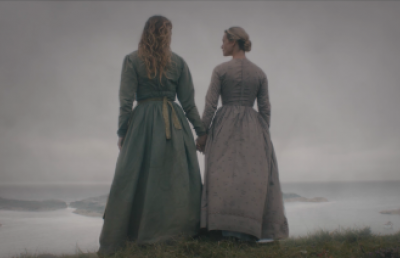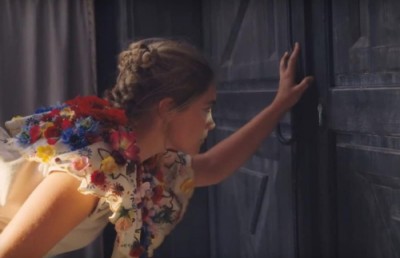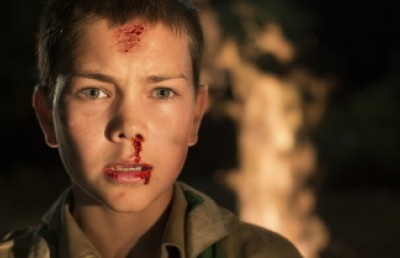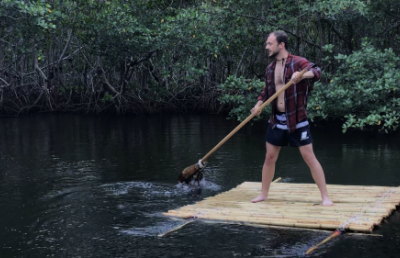Spatial Narration and World Building in the Feature Film Adore
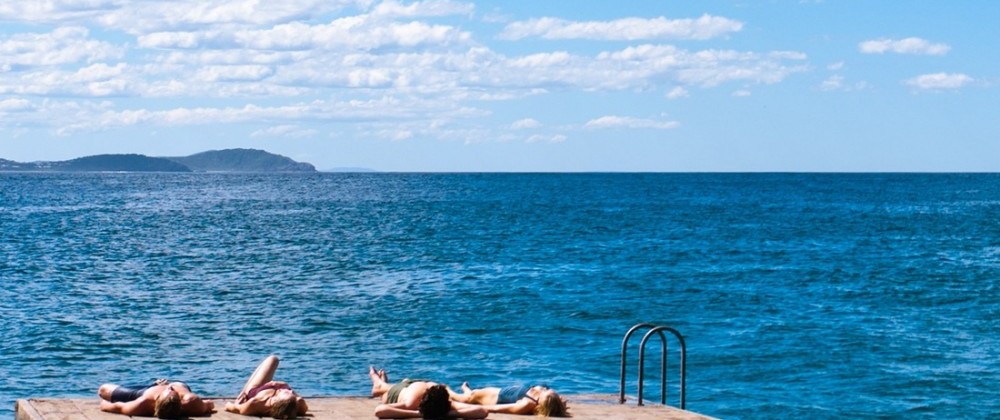
Anne Fontaine’s Adore (2013) offers a fresh look into the theme of sexual desire through its aestheticization that arises from depicting it as inextricably linked with nature. The story of two passionate love affairs unfolds in a beachfront clove that is presented as the lovers’ world in a mode primarily poetic. The unorthodox relationships of two mothers-friends with each other’s adolescent sons is a breach of moral ethics, but the film celebrates their extraordinary love through foregrounding the beachfront clove as a fitting terrain for the exploration of sexual desire. In contrast, the narrative draws the city and community rather superficially, but presents them as a combined antagonist. This essay argues that the emphasizing of nature and marginalizing of city/community works on two levels: first, it establishes an opposition between nature on the one side and city/community on the other; second, it links nature with love and sexual pleasure, while it links city/community with family and morality. This narrative strategy brings out other conceptual ramifications, such as a clash between private and public, as well as between free will and ethics.
The sense of place is traditionally explored in Australian cinema, e.g. in The Chant of Jimmie Blacksmith (Schepisi, 1978), The Proposition (Hillocat, 2005), Mystery Road (Sen, 2013), and The Dressmaker (Moorhouse, 2015) where the representation of Australian terrain (Leslie 2016) is tightly linked with telling an Australian story (Ward 2016). In some of these films, space is equipped with agency, e.g. in Mystic Road, the vast open landscape complicates the protagonist’s investigation and struggle with straddling two worlds – the indigenous and the white man’s. In an interview with Fontaine, Melissa Silverstein (2013) brings up the issue of locale in Adore, qualifying it as a character. Fontaine explains her choice of the locale by revealing that the true story, on which her film is based, happened in Australia. Fontaine says, ‘I felt that Seal Rocks (north of Sydney) had the perfect mix of seclusion, visual power, and beauty of course’ (2013), shedding a light on her intentions of empowering the setting of the story.
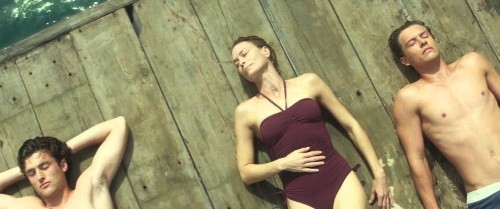
A Story of Aesthetics vs Ethics
The story in Adore revolves around two childhood friends, Roz (Robin Wright) and Lil (Naomi Watts) and their teenage sons, Tom (James Frecheville) and Ian (Xavier Samuel) respectively. After Roz refuses to move to Sydney with her husband, Harold (Ben Mendelsohn), she and Lil spend all their time together with their sons, swimming and partying. The mothers form a special bond with the boys, which soon develops into a sexual attraction. One night, Ian initiates a sexual intercourse with Roz. Tom incidentally finds them out and makes advances on Lil and eventually seduces her to have sex. The lovers continue their secret affairs until Tom’s trip to Sydney, where he starts a relationship with a young woman, Mary (Jessica Tovey). Lil realizes her affair with Tom is a transient adventure. Roz and Lil decide to end their secret affairs despite Ian’s protests. To get back at Roz, Ian demonstratively dances with Hannah (Sophie Lowe) at Tom’s birthday party, and they click. However, still desiring Roz, that same night Ian goes to her house, but she doesn’t open the door. Frustrated, Ian goes surfing at night and injures himself. Hannah helps him through a therapy. Tom and Ian get married, but after a couple of years, all four still have a glowing passion for each other. When Ian discovers that his mother and Tom have continued their relationship in secret, he tells his wife about their past affairs. Hannah and Mary leave, and the four continue their relationships.
The depicted love affairs, which turn out to be a tragic blunder, are an ethical challenge in Kierkegaardian sense. The film’s narrative curiously plays out a tug-of-war between devotion to love and commitment to family, though dipping the scales towards the former. This dichotomy reflects Kierkegaard’s reflections on Aesthetics and Ethics, where he contends that aesthetic is an immature stage in one’s life, one where an individual is concerned with their personal enjoyment; in contrast, the ethical life is based on rules established for the good of society (2000). In the first half of the film, the language of landscape inscribes a sensual voice in the narrative: in an aerial shot, we see Roz and Lil as teenagers plunging into the ocean; then the camera shows underwater images of their swimming up to the free-floating deck; they drink liquor that they hide under the deck board and sit down with their legs in the water; next they embrace each other and exchange gazes ecstatic from swimming, basking in the sun, and being together; the camera then switches to their subjective view and we see dolphins’ choreographic swimming; the scene closes with a long shot showing the girls’ small figures on the deck amidst the vastness of ocean framed as a still painting. This opening sequence establishes the motif of the burgeoning of an intimate relationship via an interaction with nature.
Cut to where the girls are middle-aged women, still living in their cliff-side houses at the same beachfront, we witness Lil’s husband’s funeral. The period, during which we partially imagine and partially see Roz and Lil as mothers and wives, is brief, downplaying their marriage and predicating their friendship on the assumption that it has grown strictly within the space of the beachfront clove. Then two catalysts – Lil’s husband’s death and Harold’s job in Sydney – reawaken Roz and Lil’s desire for ‘personal enjoyment’ and cause their ‘relapse’ into the ‘immature stage’. Freed from the burden of marriage, the two women-friends easily take up the old leisure activity of spending hours on the beach, but now with their teenage sons. Fontaine is graceful about showing images of Ian and Tom’s strong bodies surfing and how they evoke their mothers’ fascination, drawing from them comments, ‘They’re beautiful,’ ‘They’re like young Gods’ and ‘Amazing.’ But the women’s giving in to the teenage boys’ sexual advances destabilizes moral assumptions, especially in view of the priest’s funeral sermon at the beginning of the film. Halfway through the film, a need to abide by ethics arises, but despite the mothers’ decision to end the love affairs, the couples’ passion for each other proves insurmountable.
The Lovers’ World
Nevertheless, the two love affairs in Adore make sense when they are read as occurring in a world that abides by its own rules. Fontaine’s poetic approach places emphasis on images of nature structured lyrically with visual and acoustic patterns. The film focalizes on the connection between the couples’ expression of their mutual desires and the surrounding nature, thus creating a world where no social decorum reigns, and both physical and emotional experiences are the routine. Space exists out of an aesthetic intention to present nature as a device through which to flesh out the characters’ motivations within the narrative. Lotman’s theory of ‘differentiated zones in storyworld’ (1970, 238) allows to interpret Adore in terms of worlds that have particular values attributed by mise-en-scene and cinematography. In addition, Ryan argues that space in fiction is relevant for ‘what aesthetic feelings’ (2016, 39) it inspires; in her words, ‘emotional relations to space are the projection of affective relations to people’ (2016, 40). By accentuating spatial narrative through location filming Fontaine relates the characters’ love for each other to their seamless interaction with the elements of nature.
In its turn, nature can be represented as a place assigned with meaning and endowed with subjective and emotional attachment (Henlin-Stromme 2012). In the representation of lovers’ interaction with nature as connotative of sexual desire the role of sensory cinematic experiences is emphasized. The repetitive shots with Roz, Lil and the boys on the beach encourages the audience’s affective involvement (Marks 2000). The film uses optic and sensory aesthetics that enables the audience to sympathize with the two couples through guiding us to feel the sensations the lovers’ bodies experience when swimming, tanning in the sun, frolicking on and walking along the beach, watching gorgeous scenes of sunset over the ocean. The insistence on the interplay between optical and haptic makes possible sensing the couples’ vitality and pleasure.
The images of nature are overwhelming – aquamarine oceanscapes; potent waves crashing against rocks; wooded islands; sand beaches, and everlasting sunshine; houses nestled on the shoulder of a cliff in a cove. Some scenes emphasize nature through long shots by capturing the landscape on the background of which small figures of Roz and Lil relax on the beach; in other scenes, Ian and Tom surf wrestling with the big waves and competing with each other. Nature is omnipresent and even invades Roz and Harold’s bedroom in the scene where after a night with Harold Roz draws the curtains and through the big window we see a view of the ocean. This image is particularly significant because Harold has returned from Sydney to take Roz and Tom away with him, and Roz’ gesture is loaded with her inconvenient desire to stay and consummate her passion for Ian and attachment to her home – the beachfront clove.
In particular, we associate the characters’ emotions with the rhythms and impulses of the ocean and the brilliance of the sun – two basic elements of nature that can be read as tropes of sensuality, ebullience, and virility. The motif of water washing ashore in a series of scenes expresses the generating force of the land and is loaded with sexual connotations. In two scenes Roz and Lil are alone at the beach, and the waves crash ashore wetting their legs; in other scenes, the characters stride into the water, submerge and then start swimming. In a montage, Roz, Lil, Ian and Tom frolic together in the water, and then we are cut to Tom swimming to the free-floating deck to join the others; the sequence ends with all four lying on the deck holding hands. Besides associations with sexual desire, nature is also identified as that which creates love. The scene, where Ian and Roz are on the free-floating deck, subtly swaying on the calm water, reveals a romantic communion between them. Roz asks Ian to finish his cigarette, and they exchange loving gazes; alone and afloat in the vast ocean, there are no restraints and boundaries to control their waking love for each other. Nature and the lovers are also presented in a mutual symbiosis. In the scenes, where Ian and Tom compete with or fight each other, the roaring billows break upon the coast; when Tom is sad and confused after finding out his mother sleeps with Ian, he faces the sombre ocean in the dark, and the water quietly shushes at his feet. In a similar scene, where Ian is upset because Roz and Lil have decided to end the relationships, he watches the sunset over the calm ocean.
The result of the narrative’s limiting us to seeing Roz, Lil, Ian, and Tom together in paradisiacal nature is that the transgressive bonding between the women and the adolescents takes on the sense of expression of free will. Depicted as encased by vegetation and the sea, where no rationalization and moral values exist, the life of the four is shaped by primordial needs. Roz’ refusal to go to Sydney is a pivotal moment – there is no clear answer as to whether she decides to stay because she has a lifelong attachment to the beachfront or because she feels awakening to something; it is most probably because of both reasons. We constantly see Ian and Tom’s naked torsos and Roz and Lil in swimsuits; the boys’ athletic bodies are redolent of adolescent sexual energy that is manifest when they swim and ride on surfboards; as Roz and Lil relax on the beach, yearning for their youth, we see their slim aging figures. It may be argued that the beachfront clove figures as a place of desire and is tempting because its social routine has a ‘transparent’ and ‘revealing’ nature. Thus, the outburst of Ian’s passion, after the party on the veranda overlooking the ocean, is set in motion because nature summons his sexual desires. Having lived together for a long time, Roz, Lil, Ian and Tom become friends, then start flirting and then fall in love and have sex with each other, none of them questioning the deed. The only thing they care for is how they feel, which Lil asks Roz soon after they start their secret relationships. Roz responds ‘good,’ and Lil says, ‘I’ve never been this happy.’
By using nature as a resource Adore also makes a case for a special bond between Roz and Lil, which extends into their liaisons with Ian and Tom. The narrative eulogizes the two women’s relationship in two scenes, both presented as Harold’s subjective view. Both scenes are photographed in the spirit of paysage suggesting the naturalness of the relationships among the mothers and sons in contrast to Harold’s and Roz’s relationship. In the first, Roz and Lil hug their sons, and each pair symmetrically occupies the left and right sides of the frame, standing up on the background of the ocean and surrounded by bushes; in the foreground, there are truncated tree trunks. The second is a long shot where Roz and Lil walk along the beach, hugging each other, while the ocean wets their feet. Harold is jealous and Sol repulses Roz and Lil’s relationship. To Harold Roz is a ‘loan,’ a feeling that is charged with an implication that she and Lil are perhaps too intimate. When Roz and Lil are at the beach discussing Harold’s suspicions, they playfully confirm, ‘We’re not lezos,’ but reminisce how they practiced kissing with each other. The raving ocean and the ever-warming sun provide a dramatic backdrop for their ‘secret’ talk. The last shot of the scene, framed as an extreme long shot, mimics, in spatial terms, Roz and Lil’s mutual attachment and fondness. We see their tiny figures sitting on the beach, towards the right side of the frame; on the left-side, the low rock-ridge stretches across the sand and into the water, while the ocean fills most of the frame, and we hear its waves splashing and sea gulls screaming. Nature embraces the women who were born and have lived their entire lives in that nook, making their weaknesses relatable. The scene, set in the secluded beach where they hang out, symbolizes the strong association of intimate relations with nature.
City and Community – the Insignificant World
The film resists fleshing out the city and community as spaces by limiting their representation in the narrative. For example, the camera frames Roz and Lil in close shots when they are in town; Tom and Mary’s dating in Sydney is staged in dark; other brief episodes with Ian, Tom, Hannah, Roz and Lil in town are in character-centred shots, shutting out the environment. When Tom goes to Sydney to direct a play, the shift in narrative focus on space impacts the intimate world of the two couples, which loses its integrity, and we begin to sense an ominous shift in the narrative tone. Tom sleeps with Mary, while Ian, Roz and Lil hang out in town. The scene in the bar reveals that Roz and Ian don’t belong there; as they sit at a table, there is an awkward divide between their hands that cannot touch each other. In despair from Tom’s absence, Lil gets drunk. When Tom returns, he and Lil get back together, but there is a tension in their relationship: other offers and opportunities for staging performances ‘recall’ Tom; Mary calls him frequently; Tom is split between Lil and his future, of which Lil is aware, but is not able to handle. After Harold brings Mary to Tom’s birthday, the lovers’ intimate world crumbles. Tom decides to marry Mary, and Ian forced to stop dating Roz, starts a relationship with Hannah. The lovers’ world reappears towards the end, but now it is reshaped to fit into the convention endorsed by ethics. In that scene, set at the same beach where the four lovers have spent their whole lives, we see Roz and Lil as grandmothers with their sons, daughters-in-law and granddaughters.
Though underrepresented in the film, city implies achievement, development, security, and a communal life. Community figures as an implicit antagonist to the lovers’ relationships, with conventional definitions, alliances, trading, formalities and codes. Harold’s divorce from Roz and his quick marriage in Sydney is based on convention. Sol seeks a publicly visible relationship with Lil; his dating attempts with her are lame and annoying the way Sol is naively credulous that Lil can be interested in him; finally his declaration of his love in Roz’s presence comes across as somewhat a hilarious formality, devoid of romantic affection. Ian’s and Tom’s love stories with Hannah and Mary are frugally depicted and lack an emotional gravity: Ian’s relationship with Hannah is outwardly successful, but he confesses to Tom, ‘I’m gonna give her the over’; Tom’s interest in Mary resembles a temporary interest by way of a coincidence that both are studying drama. In contrast, the narrative discourse encodes a love relationship in the beachfront clove as vital and liberating, granting the right to unrestrained love, one that ‘crosses a line’ in Lil’s words. The lovers have an irresistible desire for each other; for the sake of this, the women put their public image at stake, and the boys sacrifice their families.
The film’s peculiar depiction of everyday life as a celebration of sensuality translates into a routine of adoration, but there is a latent question – how long will the relationships last? Roz’s decision that she and Lil have to end their relationships and become ‘pillars of the community’ crumbles under the pressure from a love birthed in a natural environment. In the closing shot, the two pairs of lovers are adrift on the free-floating deck, which leaves the tension between aesthetics and ethics unresolved. Though the ending is morally provoking, it is at the same time gratifying in the sense that Roz and Lil’s yearning for youth doesn’t lose the momentum as yet, and that Ian and Tom, at least for a while, can consummate their thirst for adoration of these women.
Bibliography
Henlin-Stromme, Sabine Brigitte (2012), “Nature, nation and the global in contemporary Norwegian cinema,” PhD thesis, Iowa Research Online, University of Iowa. https://ir.uiowa.edu/cgi/viewcontent.cgi?article=3039&context=etd. Accessed July 10 2018.
Kierkegaard, Soren. The Essential Kierkegaard. Princeton University Press, (2000).
Leslie, Carolyn. “The Dressmaker: Vengeance in Vogue,” Screen Education, 81, (2016), 8-17.
Lotman, Jurij M., The Structure of the Artistic Text. University of Michigan Press, (1970).
Marks, Laura. The Skin of the Film: Intercultural Cinema, Embodiment, and the Senses. Duke University Press, (2000).
Ryan, Marie-Laure, Foote, Kenneth, and Azaryahu, Maoz. Narrating Space/ Spatializing Narrative. Ohio State University Press, (2016).
Silverstein, Melissa. “Interview with Anne Fontaine – Director of Adore,” Indiewire, September, (2013). https://www.indiewire.com/2013/09/interview-with-anne-fontaine-director-of-_Adore_-208420/. Accessed 22 August 2018.
Ward, Sarah. “Shadows of a Sunburnt Country” Screen Education, No 81, (2016), 110-115.


